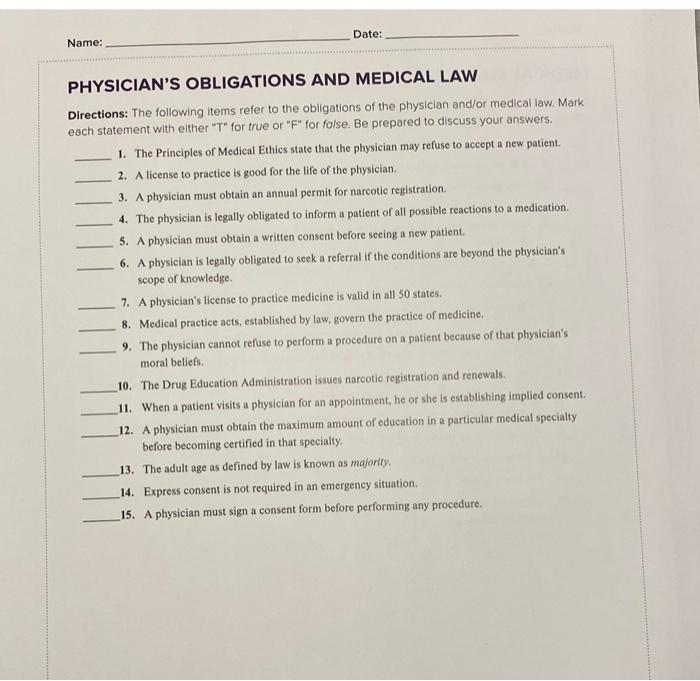Answered step by step
Verified Expert Solution
Question
1 Approved Answer
can you answer this question Directions: The following items refer to medical liability and communications. Mark each statement with either T for true or
can you answer this question 

Directions: The following items refer to medical liability and communications. Mark each statement with either "T" for true or " F " for folse. Be prepared to discuss your answers. 1. The charge of battery exists when there is a clear threat of injury to another. 2. A subpoena orders the defendant to answer the stated charges. 3. Contributory negligence may exist if the patient has failed to follow the physician's advice and treatment. 4. Access to health records is the form that contains written permission to release paticnt information. 5. Defensive medicine means the physician is dissolving legal responsibility. 6. An authorization for release of information does not have the physician's signature. 7. A statute of limitations controls the time limit for starting a lawnuit. 8. Using e-mail to transmit medical documents is peeferred over faxing documents. 9. In a lawsuit, the burden of proof that malpractice exists restr on the patient. 19. The physician may be charged with medical abundonment if the physician discontinues care without sending proper notification to the patient. 11. Statutory reports require that the patient's condition be reported to the patient's insurance. 12. Operating beyond the patient's expressed consent may establish a charge of battery. 13. A deposition is sent to the defendant requiring the defendant's appearance in court. 14. The Good Samaritan Act states that a patient may start a lawsuit upon reaching majority. 15. HIPAA is a federal law that protects the security and privacy of a potient's electronic health information. Directions: The following items refer to the obllgations of the physician and/or medical law. Mark each statement with either " T " for true or " F " for false. Be prepared to discuss your answers. 1. The Principles of Medical Ethics state that the physician may refuse to accept a new patient. 2. A license to practice is good for the life of the physician. 3. A physician must obtain an annual permit for narcotic registration. 4. The physician is legally obligated to inform a patient of all possible reactions to a medication. 5. A physician must obtain a written consent before seeing a new patient. 6. A physician is legally obligated to seek a referral if the conditions are beyond the physician's scope of knowledge. 7. A physician's license to practice medicine is valid in all 50 states. 8. Medical practice acts, established by law, govern the practice of medicine. 9. The physician cannot refuse to perform a procedure on a patient because of that physician's moral beliefs. 10. The Drug Education Administration issues narcotic registration and renewals. 11. When a patient visits a physician for un appointment, he or she is establishing implied consent. 12. A physician must obtain the maximum amount of education in a particular medical specialty before becoming certified in that specialty. 13. The adult age as defined by law is known as majority. 14. Express consent is not required in an emergency situation. 15. A physician must sign a consent form before performing any procedure 

Step by Step Solution
There are 3 Steps involved in it
Step: 1

Get Instant Access to Expert-Tailored Solutions
See step-by-step solutions with expert insights and AI powered tools for academic success
Step: 2

Step: 3

Ace Your Homework with AI
Get the answers you need in no time with our AI-driven, step-by-step assistance
Get Started


